Los mejores y los peores ejercicios para problemas de cadera
Your guide to preventing falls, maintaining mobility, and relieving aching hips and pain for years to come.
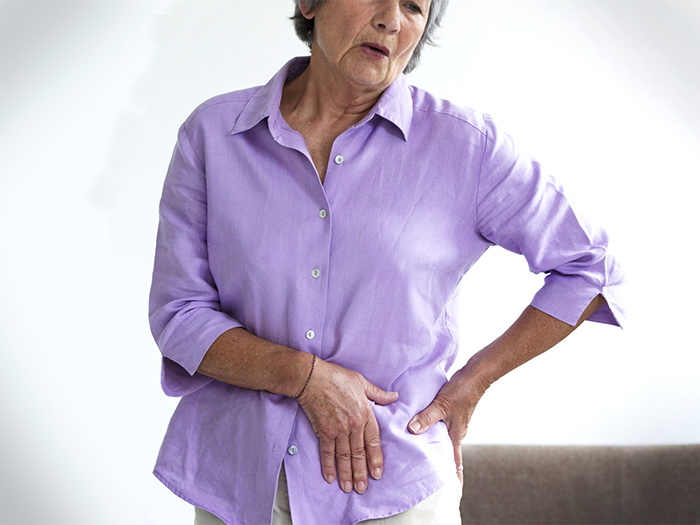
If you have aching hips, taking it easy might seem like the best prescription. Rest is sometimes necessary, but hip pain is often a sign that you should embrace more movement.
Too much sitting is the enemy of stiff or aching hips, says Lisa Woods, a personal trainer and yoga teacher in Eagle, Colorado. The big problem, though, isn’t just the discomfort in the sides of your thighs. It’s the chain of pain that dysfunctional hips can create, including sciatic nerve pain that can start in your lower back and go down the backs of your legs.
The hip joint is designed to withstand a fair amount of wear and tear, but it's not indestructible. For example, when you walk, a cushion of cartilage helps prevent friction as the hip bone moves in its socket. With age and use, this cartilage can wear down or become damaged, or the hip bone itself can be fractured during a fall. In fact, more than 300,000 adults over 65 are hospitalized for hip fractures each year, according to the Agency for Healthcare Research and Quality.
The good news: You’re not powerless against hip problems. The right exercise routine can go a long way in helping you prevent falls, maintain mobility, and manage pain.
Here are the best exercises for aching hips and the exercises you should limit or avoid. Como siempre, la clave es la seguridad. Los ejercicios aquí podrían ser distintos o más avanzados que los de que aplicará en una clase SilverSneakers. If you have a chronic condition, balance issues, or injuries, talk to your doctor about how you can exercise safely.
Stay active, have fun, get fit—with SilverSneakers! Classes and events are happening right now at participating gyms, online through SilverSneakers LIVE and at community centers near you. Activate your free online account to get started.
The Best Exercises for Aching Hips
The first step in fighting hip pain is simple: Move your body. If you sit a lot, even small amounts of movement or standing throughout your day can be beneficial, Woods says.
When it comes to your workouts, low-impact aerobic exercises are generally best and least likely to cause issues, says Kelton Vasileff, M.D., an orthopedic surgeon at Ohio State University Wexner Medical Center. “I recommend swimming, walking, elliptical, cycling, and stationary biking for general exercise,” he says. All of these are great ways to move your body without pounding your joints.
Strength training is another key part of the "do" category, Dr. Vasileff says. "It's a good idea to focus on quad, hamstring, and glute strength," he says. These muscles surround your hips and provide support, along with your core-which is another area to focus on. "Strengthening your core helps to normalize your walking pattern and stabilize how your pelvis and hips move," Dr. Vasileff says. That translates to less pain and better hip mobility.
Try incorporating any or all of the following hip exercises into your routine two or three days per week.
1. Band Side Step
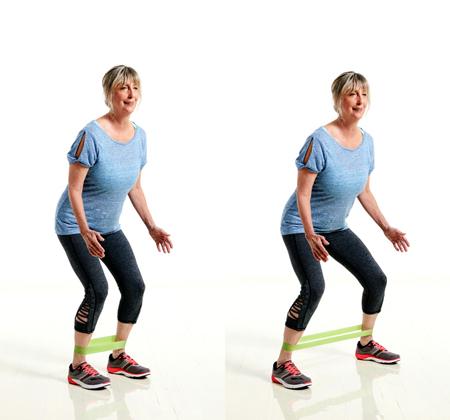
Loop a resistance band above your knees (least resistance), below your knees (medium resistance), or around your ankles (greatest resistance). Bend knees slightly with your feet hip-width apart.
Step to the side until the band provides resistance, then slide your other foot over to re-create your original stance. Repeat this sidestepping movement for 10 to 15 feet in one direction (or as far as you can), and then cover the same distance in the other direction.
Make it easier: Try seated band abductions. With the resistance band tied just below your knees, sit tall with feet about shoulder-width apart. Push your knees outward against the band, pause, and then release. Aim for 10 to 15 reps total.
2. Elevación de rodilla sentado
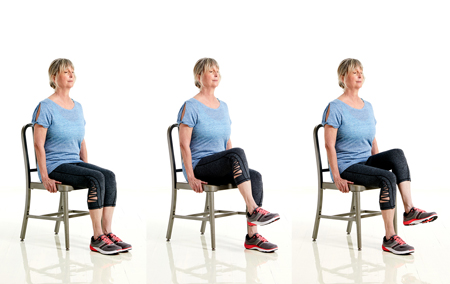
Sit at the front of your chair with knees bent and feet flat, holding on to the sides for balance. Puede hacer este ejercicio con los ojos abiertos. O para una concentración más profunda y un desafío del equilibrio, pruébelo con los ojos cerrados.
With your knee bent, lift your right leg about six inches off the floor (or as far as you can). Hold for three counts, and then lower it back to the floor. Repeat with your left leg for one rep. Do 10 reps total.
3. Seated Leg Extension
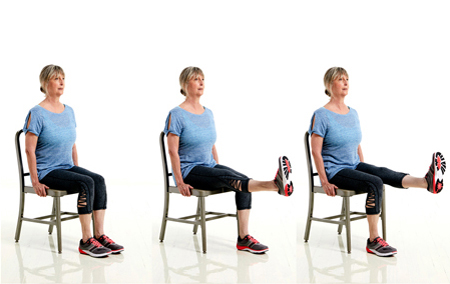
Siéntese hacia el frente de su silla con las rodillas dobladas y los pies apoyados, agarrándose a los lados para mantener el equilibrio.
Manteniendo el pie izquierdo plantado y la parte superior del cuerpo inmóvil, estire la rodilla derecha hasta que la pierna esté paralela al suelo. Hold for two counts, and then lower it back to the floor. Haga 10 repeticiones a la derecha, luego repita a la izquierda.
4. Flexión de caderas
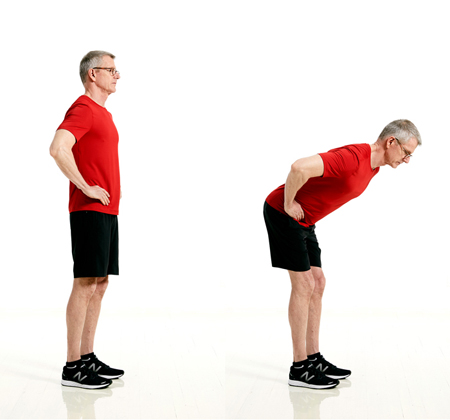
Stand with your feet hip-width apart, knees slightly bent, and hands on hips. Tense su abdomen, imagine que está a punto de recibir un puñetazo en el estómago.
Without changing the position of your knees, bend at your hips and lower your torso until it's almost parallel to the floor (or as far as you can comfortably go without rounding your back). Haga una pausa, luego levante el torso de regreso a la posición inicial. Asegúrese de apretar los glúteos y empujar las caderas hacia adelante para levantar el torso de nuevo a la posición inicial. Esto asegura que está utilizando los músculos de la cadera en lugar de depender de la zona lumbar. Do 10 reps total.
5. Postura de perdiguero
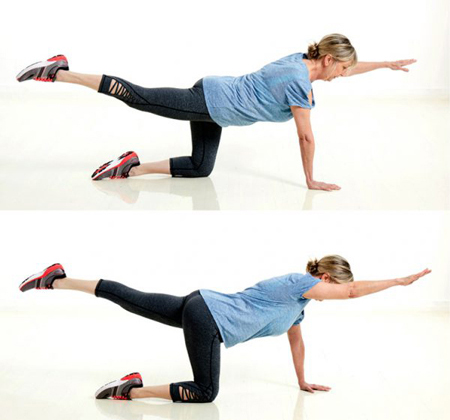
Empiece apoyándose en las manos y las rodillas, con las palmas de las manos sobre la esterilla o en el piso y ubicadas debajo de los hombros. El cuello tiene que estar alineado con la espalda y debe mirar hacia abajo o ligeramente hacia delante.
Contraiga el abdomen y levante el brazo izquierdo y la pierna derecha hasta que estén alineados con su cuerpo. Mantenga la posición de cinco a 10 segundos, y luego vuelva a la posición inicial. Repita con el lado opuesto (brazo derecho y pierna izquierda) para completar una repetición. Trate de hacer de cinco a siete repeticiones en total.
Hágalo más fácil: Mantenga las manos en el suelo y solo extienda la pierna.
Suscríbase a nuestro boletín informativo
Es rápido y fácil: Usted podría estar entre las 13 millones de personas elegibles.
¿Ya es miembro? Haga clic para descubrir nuestros más de 15,000 centros participantes.
Síganos
The Cherry on Top: Yoga
In addition to low-impact cardio and strength exercises like the ones above, yoga can “work wonders for tight hips,” Woods says. The way yoga combines stretching and strengthening the muscles in your hips, legs, and glutes is ideal for helping relieve pain.
One study from Florida Atlantic University found that doing 45 minutes of chair yoga twice per week reduced pain and improved overall quality of life in older adults with osteoarthritis. Chair yoga is practiced sitting in a chair or standing while holding the chair for support, so it’s a great option for beginners or anyone dealing with an injury or balance problems.
Whichever style of yoga you try, seek out proper instruction from a yoga teacher to ensure you’re performing postures correctly. And tell your instructor about any pain or injuries before class so they can suggest modifications. Check out SilverSneakers Yoga or yoga classes, which are offered in-person at participating locations , community centers, or online through SilverSneakers LIVE.
Recommended FREE SilverSneakers On-Demand Class: Chair Yoga for Seniors—Invigorating Total Body Yoga
The Worst Exercises for Aching Hips
In general, if an exercise causes pain in your hips, it's best to avoid it, Dr. Vasileff says. It's simple but valuable advice. Common pain-inducing activities are pretty predictable, Dr. Vasileff says. Incluyen:
- Walking on uneven ground or hiking
- High-impact activities such as faster-pace running or jumping
- Lifting heavy weights
Dr. Vasileff also advises against any exercises that require extreme ranges of motion, which he defines as more than 90 degrees of bend at the hip or knee. Deep squats are an example of this type of movement.
Woods includes lunges and stepups in the "don't" category. "It can be difficult for those with troubled hips to maintain proper form in these poses, which places additional strain on the hips," she says.
Activate Your FREE SilverSneakers Online Account
Get hundreds of free SilverSneakers On-Demand videos and stay in touch with us by creating your free online account. You don’t have to be a SilverSneakers member to get on-demand workout videos, health and fitness tips from SilverSneakers, and more.
SilverSneakers members can go to thousands of nationwide gyms and fitness locations, plus take SilverSneakers LIVE online classes led by specially trained instructors and designed for all fitness levels and abilities – at no additional cost. If you have a Medicare Advantage plan, it may include SilverSneakers. Check your eligibility here.
Already a member? Get your SilverSneakers member ID, search for locations near you, and all the health and wellness resources you need by logging in to your online member account here.




